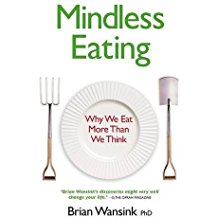 Mindless Eating: Why We Eat More than We Think by Brian Wansink, Ph.D., Bantam Books, 2006, new editions available along with new resources. Check out Dr. Wansink’s website at mindlesseating.org. You can even get a free refrigerator magnet!
Mindless Eating: Why We Eat More than We Think by Brian Wansink, Ph.D., Bantam Books, 2006, new editions available along with new resources. Check out Dr. Wansink’s website at mindlesseating.org. You can even get a free refrigerator magnet!
I can’t believe that I haven’t written about this book before now. There are later editions, but I made sure to use the cover image from the version I have because I love the use of the pitchfork and shovel as eating implements. Once you read this book (read this book!) you will never again think that we eat only because we’re hungry.
Dr. Wansink runs a food lab at Cornell University and has carried out extensive experiments over the past 20 years that demonstrate how much our eating is influenced by cues that we are completely unaware of. One very helpful idea in the book is that we have limited willpower, and so we need to not exhaust it by constantly exposing ourselves to temptation. That’s why (is everybody listening?) it’s such a terrible idea to have sweets and snacks on hand, whether at work or at home. We have to keep saying “no, no, no,” and eventually one or more of those no’s becomes a yes. And this process isn’t just psychological; it’s also physiological. We know that the pancreas starts secreting insulin as we smell, see, and salivate over food, since we need to stay ahead of the curve in order to maintain normal blood-sugar levels. The proactive insulin lowers blood sugar, and so we feel hungry. That’s fine if we’re getting ready to eat a normal meal, but not so fine if we’re constantly gazing at a bowl of roasted cashews. (I could never have such a thing sitting in our house, or I would be as big as said house. I have very little resistance in this area.)
The funniest experiment that Wansink has carried out is that of the bottomless soup bowl. He rigged up a table in his lab with bowls that had a tube attached underneath leading to a vat of soup. No matter how much soup his unsuspecting diners ate, the level stayed the same. For each session, two bowls were bottomless and two were normal. People eating from the refilling bowl ate up to three times as much soup as those eating from the regular ones. They just didn’t notice how much they were eating, because there were no visual cues to tell them. And it wasn’t some kind of gourmet soup made with fresh tomatoes and heavy cream; it was plain old Campbell’s from a can.
Ultimately, Wansink’s ideas about improving our eating habits are very, very simple and doable. You could pick just one of his suggestions to try out and see what a difference it makes. I think one of the best and easiest is also the least original with him: if you want to eat less, you need to slow down: “In reality, scientists don’t know exactly what makes us feel full. It seems to be a combination, among other things, of how much we chew, how much we taste, how much we swallow, how much we think about the food, and how long we have been eating. What does seem to be the case is that the faster we wolf down our food, the more we eat, because this combination of cues doesn’t get the chance to tell us we’re no longer hungry. Many research studies show that it takes up to 20 minutes for our body and brain to signal satiation, so that we realize we are full. Twenty minutes is enough time to inhale two or three more pieces of pizza and chug a large refill of Pepsi” (p. 46, emphasis mine).